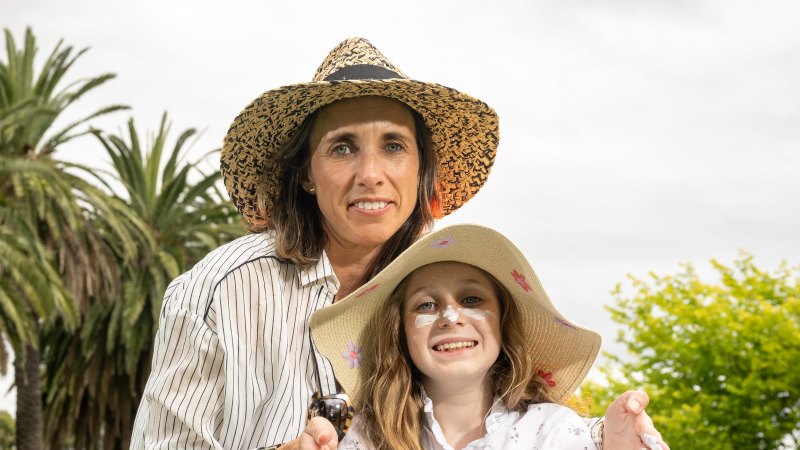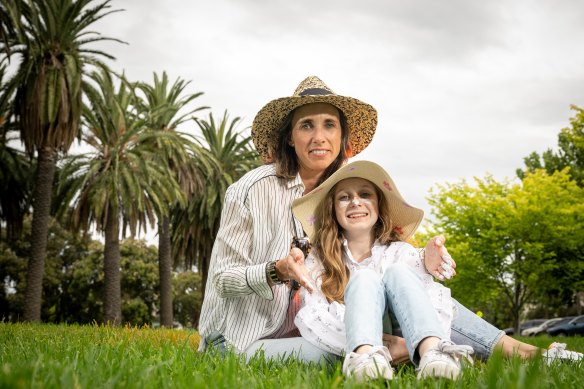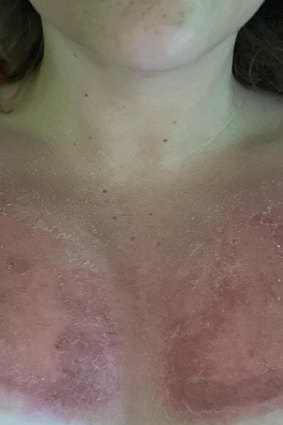
When a day in the sun ends in the emergency room
December 14, 2023Save articles for later
Add articles to your saved list and come back to them any time.
Hundreds of Victorians are presenting to hospital emergency departments with severe sunburn, with children and teenagers making up almost half the cases.
The state’s hospitals treated 274 people who had scorched their skin so badly they required medical treatment for extensive blistering, pain, headache, vomiting or fevers in the 2022-23 financial year.
Mia Jones is incredibly cautious of the sun and always makes sure her daughter Ellie, 10, is wearing hats, sunglasses and sunscreen.Credit: Eddie Jim
SunSmart head of skin cancer prevention programs Emma Glassenbury said the statistics were alarming because every sunburn increased a person’s risk of developing skin cancer later in life.
“This is our peak period for sunburn, which is an immediate result of UV damage causing pain and trauma to the skin that can increase your risk of developing skin cancer,” she said.
Glassenbury suspects many people are relying too heavily on sunscreen for protection – but forgetting to wear hats, long-sleeved clothing and sunglasses and to seek shade.
“Sunscreen is not a suit of armour,” she said. “While sunscreen is great, it doesn’t give you indefinite protection.”
More than 5000 people have wound up in Victorian emergency departments with severe sunburn since 2004, with presentations most common among people aged 15 to 24. Younger children were also over-represented in the data, with 1445 children seeking emergency department treatment for sunburn during this period.
Glassenbury said UV levels were so intense in some parts of the state that people could burn in 11 minutes without protection.
Director of the Victorian Melanoma Service at The Alfred hospital Associate Professor Victoria Mar said that in severe cases, sunburn needed to be wrapped in dressings and monitored for secondary infection.
Sunburnt patients might also be given cool compresses, pain relief, anti-inflammatory medication and additional fluids.
Mar said while healthcare workers could treat the immediate symptoms of sunburn, they were unable to reverse the long-term skin damage.
“It’s worrying that we continue to see high numbers of teenagers and young adults
present to emergency departments to treat a condition that is avoidable,” she said.
Australians have the world’s highest rates of melanoma, with about 69 cases detected per 100,000 people per year.
Head of cancer control at QIMR Berghofer Medical Research Institute Professor David Whiteman said while melanoma rates were climbing among Australians aged over 50, they were falling among younger age groups.
“Older Australians are still paying the price of sun exposure that happened more than 30 years ago,” he said. “We have a lot of Australians who grew up in an era where there was not much sun protection.”
Whiteman said Australians under 40 had lower rates of melanomas due to the effectiveness of “slip slop slap” sun-protection campaigns, but warned there was no room for complacency.
He said Australia’s elevated melanoma rates were due to high UV levels, large numbers of Australians having fair skin and effective cancer detection.
Mother-of-three Mia Jones is vigilant when it comes to protecting her children from the sun, especially her fair-skinned daughter Ellie, 10.
She helps them regularly apply sunscreen, makes sure they wear hats and sunglasses and encourages them to seek shade on hot days.
When the UV levels are extreme, the Albert Park family stays indoors.
“I am very aware of the power of the sun,” she said.
Last summer Ellie was sunburnt on her face after a day out on a boat and struggled to fall asleep due to the discomfort. Jones suspects her daughter was burnt after rubbing her eyes following a swim, removing the sunscreen.
Danielle Loughnan spent four days in bed earlier this year after a severe sunburn.
“I have bought her a special zinc cream for under her eyes to make sure it doesn’t happen again,” Jones said.
Danielle Loughnan spent four days in bed with severe sunburn at the start of this year after a day swimming in her friend’s pool.
She had worn a hat, sunglasses and applied sunscreen – but did not wait the recommended 20 minutes for it to create a protective barrier before jumping into the pool.
“That night it got redder and redder and more painful,” she said.
“A friend’s mum who was a nurse looked at me and said, ‘that looks like a third-degree burn’.”
The 28-year-old, who lives in Preston, said it took a week to recover. She took anti-inflammatory medication and was unable to drive because of the agony of the seatbelt touching her skin.
“This summer I’ll be reapplying sunscreen like there’s no tomorrow,” she said.
Start the day with a summary of the day’s most important and interesting stories, analysis and insights. Sign up for our Morning Edition newsletter.
Most Viewed in National
From our partners
Source: Read Full Article



